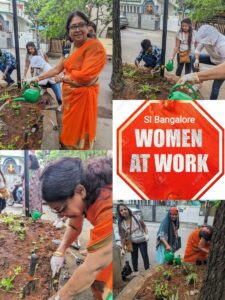 “Healing People Heal the Planet.” That was the title of an unusual documentary that I had the pleasure of viewing at the NGO Commission on the Status of Women Forum in March in New York.
“Healing People Heal the Planet.” That was the title of an unusual documentary that I had the pleasure of viewing at the NGO Commission on the Status of Women Forum in March in New York.
The premise of the documentary by AHAM Education is that we can try to solve the personal distress surrounding ecological changes by including healing practices, like mindfulness, while participating in ecological activism.
If we survey the state of the planet through news and articles online, we will understand the need to act consciously from a centre of peace. There are unseen ecological disasters that we cannot predict or mitigate – like the recent trauma of a month-long oil spill from a barge that devastated the pristine aqua waters and coral reefs off the coast of Trinidad’s sister isle, Tobago, my Caribbean home.
Or, if we take a look around the Federation, the news usually seems dire:
- A recent study claimed that UK forests are headed for “catastrophic ecosystem collapse” within the next 50 years due to disease, extreme weather and wildfires.
- In green, lush Ireland, the Environmental Protection Agency reports that only 20 rivers and lakes have pristine water, as opposed to more than 500 in the 80s, while 250,000 hectares of wetlands have been lost in the last two decades.
- In India, climate-change induced natural disasters like floods and cyclones have increased substantially in the past 50 years.
- A decrease in biodiversity in Malta placed it as one of the countries at risk of ecosystem collapse, according to a 2020 report.
The big picture on the environment is distressing, some say alarmist. However, it gives us the opportunity to collectively and individually take action, raise awareness and inspire change for a healthy planet.
In a conversation with a sister Soroptimist, I heard the sense of fatigue and cynicism at what seemed to be the daunting task of dealing with plastic pollution, the 2024 theme at EarthDay.org. In the battle of Planet vs. Plastics, she felt it was the responsibility of the plastic bottle manufacturers to ensure their bottles were recycled. While that is undoubtedly true, as individuals we also have a choice: to be a part of the problem, or a part of the solution.
In my local club, SI Chaguanas, we raised awareness of the need to reduce single-use plastics through a social media campaign featuring various forms of ocean life protesting against the pollution of their home, the sea, by humans and suggesting tips on their placards. You can view the five videos here:
- https://www.facebook.com/SIChaguanas/videos/577503297219184
- https://www.facebook.com/SIChaguanas/videos/3329494787304145
- https://www.facebook.com/SIChaguanas/videos/1029667924413181
- https://www.facebook.com/SIChaguanas/videos/1382491765564877
- https://www.facebook.com/SIChaguanas/videos/2173324889506465
On an individual level, we are already implementing some of those tips: recycling plastic containers and beverage bottles, using a reusable cup for drinks, carrying reusable shopping bags, reusing plastic grocery bags, carrying reusable cutlery, cleaning up plastic garbage in the neighbourhood, using a sustainable lunch box or bag, choosing food and veggies that aren’t pre-packaged in plastic, using metal straws and bulk buying.
Like many Soroptimist clubs we also engage in other environmental endeavours like tree planting, and tree and vegetable plant donations to schools and the community. We’ve even published a children’s comic book to teach them about renewable energy.
Soroptimist clubs throughout SIGBI have also taken the lead on the plastic problem with projects that include lobbying local supermarkets to take ownership of recycling single use plastics, signing Greenpeace petitions to stop plastic producing nations from recycling their waste in other countries, raising awareness of club members’ use of plastic via a Plastic Count form, lobbying plastic manufacturers to start making materials that are compostable, and beach clean-ups.
They may seem like small steps in the big planetary picture, but every action counts, and the reasoning is compelling: single-use plastics break down into microplastics that release toxic chemicals into our food and water sources, the air we breathe and even the bloodstream. Plastic production has increased to more than 380 million tonnes per year and more plastic has been produced in the last 10 years than in the entire 20th century (earthday,org).
While the statistics and climate outlook seem grim, there is optimism that large-scale climate activities around the world can have a meaningful impact on the state of the earth’s health. The United Nations Development Programme maintains that we do have the solution to the planet’s challenges and they depict just that in a new video series on YouTube, Climate Action Explained. The videos take viewers on a world tour featuring viable and scalable climate solutions from 12 countries around the world:
- The South Pacific island of Tuvalu, where devastating flooding and coastal erosion is being countered by rehabilitating the coastal line
- Kenya, where the battle against water scarcity is effected through involving local communities and harnessing their knowledge to find adaptation strategies that work
- The Life Plan programme in Ecuador, that supports local and indigenous peoples in making informed decisions about managing their forests and natural habitats while making a living through agriculture
- The Solar for Health programme which provides solar panels to hospitals and other facilities to generate electricity in Zimbabwe.
And the list goes on.
The point remains, this is our one planet, our forever home. Together, we can meaningfully change its course as countries, societies, communities, clubs and individuals.
Together, let’s heal the planet.
Nalini Parasram-Rajballie
SI Chaguanas, Trinidad and Tobago


